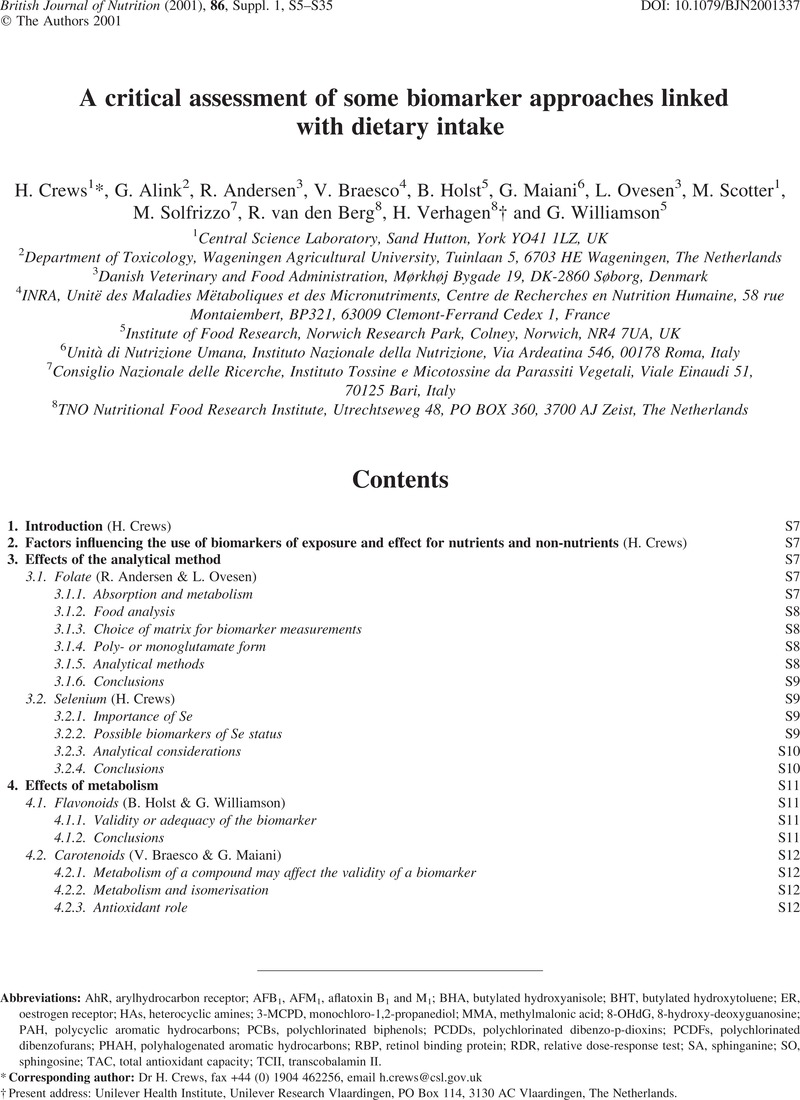Crossref Citations
This article has been cited by the following publications. This list is generated based on data provided by Crossref.
Anderson, Warwick A. C.
Barnes, Karen A.
Castle, Laurence
Damant, Andrew P.
and
Scotter, Michael J.
2002.
Determination of isotopically labelled monoesterphthalates in urine by high performance liquid chromatography-mass spectrometry.
The Analyst,
Vol. 127,
Issue. 9,
p.
1193.
Monro, J.A.
2002.
The Nutrition Handbook for Food Processors.
p.
165.
Kay, Colin D.
and
Holub, Bruce J.
2002.
The effect of wild blueberry (Vaccinium angustifolium) consumption on postprandial serum antioxidant status in human subjects.
British Journal of Nutrition,
Vol. 88,
Issue. 4,
p.
389.
Hall, Kristyn D.
Stephen, Alison M.
Reeder, Bruce A.
Muhajarine, Nazeem
and
Lasiuk, Gail
2003.
Diet, Obesity and Educationin Three Age Groups of Saskatchewan Women.
Canadian Journal of Dietetic Practice and Research,
Vol. 64,
Issue. 4,
p.
181.
Kay, Colin D.
and
Holub, Bruce J.
2003.
The postprandial effects of dietary antioxidants in humans.
Current Atherosclerosis Reports,
Vol. 5,
Issue. 6,
p.
452.
McNaughton, S. A.
and
Marks, G. C.
2003.
Development of a food composition database for the estimation of dietary intakes of glucosinolates, the biologically active constituents of cruciferous vegetables.
British Journal of Nutrition,
Vol. 90,
Issue. 3,
p.
687.
Davis, Cindy D.
2003.
Use of Exfoliated Cells from Target Tissues to Predict Responses to Bioactive Food Components.
The Journal of Nutrition,
Vol. 133,
Issue. 6,
p.
1769.
Dorea, Jose G.
2003.
Fish are central in the diet of Amazonian riparians: should we worry about their mercury concentrations?.
Environmental Research,
Vol. 92,
Issue. 3,
p.
232.
Maruvada, Padma
and
Srivastava, Sudhir
2004.
Biomarkers for Cancer Diagnosis: Implications for Nutritional Research.
The Journal of Nutrition,
Vol. 134,
Issue. 6,
p.
1640S.
McCullough, Marjorie L
and
Giovannucci, Edward L
2004.
Diet and cancer prevention.
Oncogene,
Vol. 23,
Issue. 38,
p.
6349.
Johns, Timothy
and
Sthapit, Bhuwon R.
2004.
Biocultural Diversity in the Sustainability of Developing-Country Food Systems.
Food and Nutrition Bulletin,
Vol. 25,
Issue. 2,
p.
143.
Ross, Alastair B.
Kamal-Eldin, Afaf
and
Åman, Per
2004.
Dietary Alkylresorcinols: Absorption, Bioactivities, and Possible Use as Biomarkers of Whole-grain Wheat- and Rye-rich Foods.
Nutrition Reviews,
Vol. 62,
Issue. 3,
p.
81.
McNaughton, S A
Marks, G C
Gaffney, P
Williams, G
and
Green, A
2005.
Validation of a food-frequency questionnaire assessment of carotenoid and vitamin E intake using weighed food records and plasma biomarkers: The method of triads model.
European Journal of Clinical Nutrition,
Vol. 59,
Issue. 2,
p.
211.
Coolen, S. A. J.
van Buuren, B.
Duchateau, G.
Upritchard, J.
and
Verhagen, H.
2005.
Kinetics of biomarkers: biological and technical validity of isoprostanes in plasma.
Amino Acids,
Vol. 29,
Issue. 4,
p.
429.
CARPENTER, CATHERINE L.
2006.
Nutritional Oncology.
p.
367.
Voutilainen, Sari
Nurmi, Tarja
Mursu, Jaakko
and
Rissanen, Tiina H
2006.
Carotenoids and cardiovascular health .
The American Journal of Clinical Nutrition,
Vol. 83,
Issue. 6,
p.
1265.
GREENWALD, PETER
and
MILNER, JOHN
2006.
Nutritional Oncology.
p.
349.
Tricon, S.
Willers, S.
Smit, H. A.
Burney, P. G.
Devereux, G.
Frew, A. J.
Halken, S.
Høst, A.
Nelson, M.
Shaheen, S.
Warner, J. O.
and
Calder, P. C.
2006.
Nutrition and allergic disease.
Clinical & Experimental Allergy Reviews,
Vol. 6,
Issue. 5,
p.
117.
Shurubor, Yevgeniya I
Matson, Wayne R
Willett, Walter C
Hankinson, Susan E
and
Kristal, Bruce S
2007.
Biological variability dominates and influences analytical variance in HPLC-ECD studies of the human plasma metabolome.
BMC Clinical Pathology,
Vol. 7,
Issue. 1,
Åman, Per
Ross, Alastair B.
Landberg, Rikard
and
Kamal‐Eldin, Afaf
2007.
Whole Grains and Health.
p.
209.



